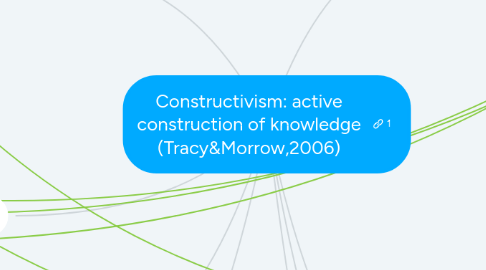
1. Transactional/Reading Response Theory
1.1. Each reader has a unique background schema that individualizes reading experiences (Tracy&Morrow,2006, pg.55).
1.2. Students will have two kinds of responses to texts
1.2.1. Efferent responses are fact-oriented and Aesthetic responses are personally and emotionally based (Tracy&Morrow,2006)
1.2.1.1. Focus on efferent responses for expository text and literature for aesthetic responses.
1.2.1.1.1. Text-to-self, text-to-text,text-to-world
1.3. Every reading act is an event, or a transaction involving a particular reader and a particular patter of signs, a text, and occurring at a particular time in a particular context (Rosenblatt, 2013, pg.8)
1.4. The teaching of reading and writing at any stage should be concerned with the environments and activities in the students are encouraged to make live meanings using their own resources (Rosenblatt,2013)
2. Psycholinguistic Theory
2.1. Reading is primarily a language process, readers rely on language cueing systems to help them rapidly read text (Tracy&Morrow,2006).
2.1.1. Syntactic
2.1.1.1. Grammar cues
2.1.2. semantic
2.1.2.1. meaning cues
2.1.3. graphophonic
2.1.3.1. visual patterns cues of letters and words with their sounds
2.2. Readers predict, or make a hypothesis, based on what they think the text will say. They test their hypothesis and continue to read, or decode word by word (Tracy&Morrow,2006).
3. Whole Language Theory
3.1. Reading is a natural process that children acquire if immersed in high-quality literacy environments and exposed to meaning, authentic literacy experiences and high quality literature (Tracy&Morrow,2006, pg. 59).
4. Engagement Theory
4.1. Readers are intrinsically motivated to read and read frequently (Tracy&Morrow,2006, pg. 64).
4.2. Increase readers engagement by... the use of themes in reading instruction, emphasis on student choice, use of hands-on activities, availability of a wide range of genres and the integration of social collaboration (Tracy&Morrow,2006 pg. 65)
5. Schema Theory
5.1. A reader comprehends a message when he is able to bring to mind a schema that gives a good account of the objects and events described in the message (Anderson,1984,pg.169).
5.1.1. Interactive process of the following levels
5.1.1.1. Graphophonemic level
5.1.1.2. Morphemic level
5.1.1.3. Semantic level
5.1.1.4. Syntactic level
5.1.1.5. Interpretive level
5.1.1.6. Pragmatic level
5.1.2. Six functions of schemata
5.1.2.1. Schema provides ideational scaffolding for assimilating text information (Anderson, 1984, Pg. 473).
5.1.2.2. Schema facilitates selective allocation of attention (Anderson, 1984, pg. 474).
5.1.2.3. Schema enables inferential elaboration (Anderson, 1984, pg. 474).
5.1.2.4. Schema allows orderly searches of memory (Anderson, 1984, pg. 474).
5.1.2.5. Schema facilitates editing and summarizing (Anderson, 1984, pg. 474).
5.1.2.6. Schema permits inferential reconstruction (Anderson, 1984, pg. 474).
5.1.3. If using this theory for classroom instruction, publishers need to design curriculum in a way that help children activate relevant knowledge before reading. The manuals need to include suggestions on building prerequisite knowledge. There can be featured lessons to integrate what children already know with what is in the book. Finally, there needs to be devices that will highlight the structure of text materials (Anderson, 1984).
5.1.4. According to Luke& Freebody (1997), they are trying to shift this idea of schema being an individualized wealth of knowledge a student brings to school, to a individualized wealth of knowledge brought based on what the children have access to in regards of gender, culture, SES and language.
5.2. Everyone's schemas are individualized and constantly changing (Tracy&Morrow,2006).
6. Inquiry Learning
6.1. Students need to formulate hypotheses, collect data to test hypotheses, draw conclusions, and reflect on the original problem and the thinking processes needed to solve it (Tracy&Morrow,2006,Pg.49).
6.2. Inquiry learning emphasizes hypothesizing and inferencing.
7. Metacognition instruction
7.1. Thinking about thinking as an independent strategy to use when comprehending a text (Tracy&Morrow,2006).
7.1.1. "think alouds" during guided reading
8. Work Cited
8.1. Anderson, R. C. (1984). Role of the reader’s schema in comprehension, learning, and memory. In R. C. Anderson, J. Osborn, and R. J. Tierney (Eds.), Learning to read in American schools: Basal readers and content texts (pp. 243-257). Erlbaum.
8.1.1. Luke, A., & Freebody, P. (1997). Shaping the Social Practices of Reading. Constructing Critical Literacies: Teaching and Learning Textual Practice, 185-226.

